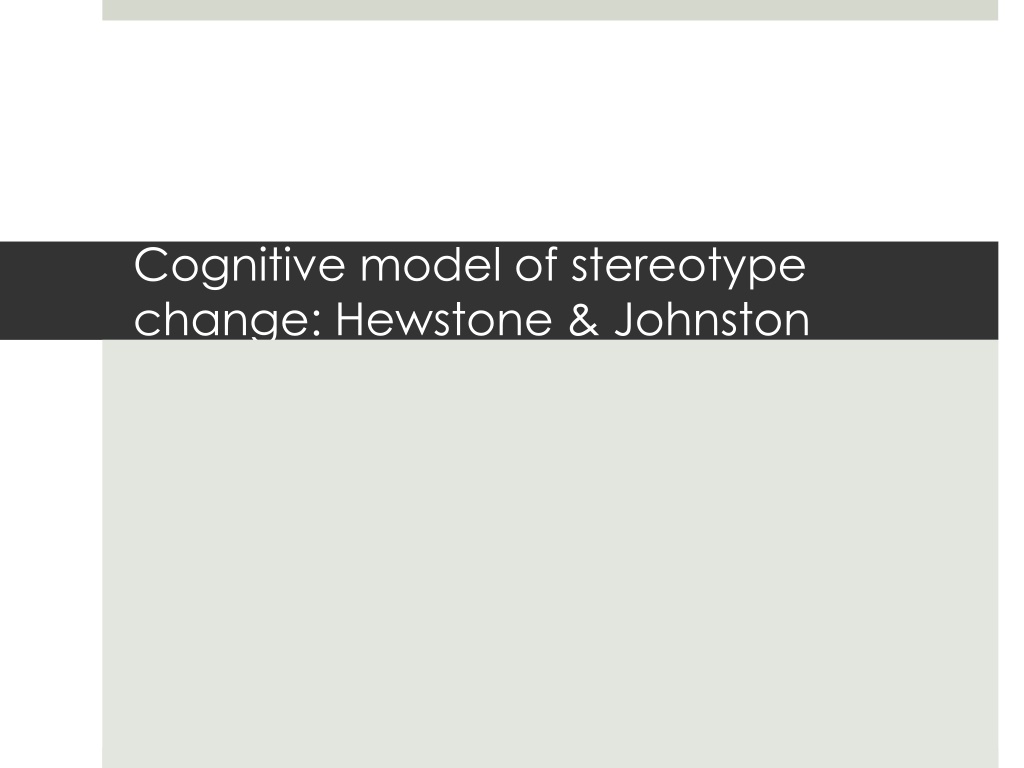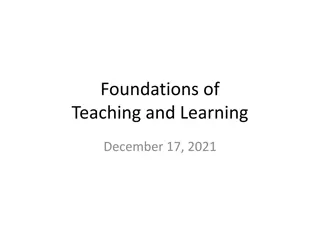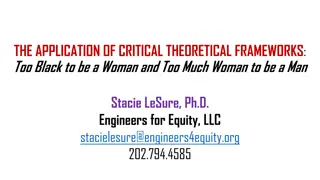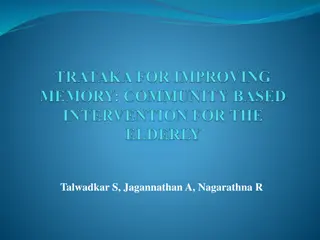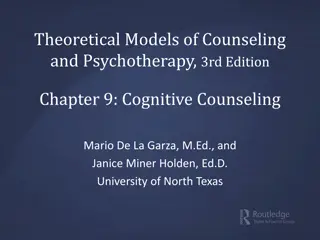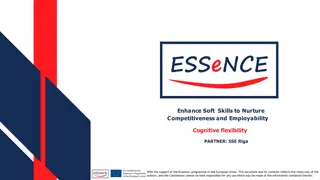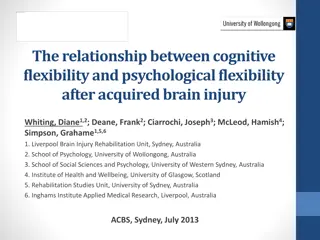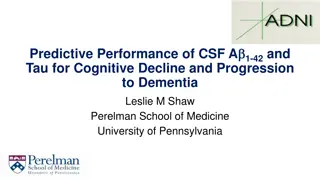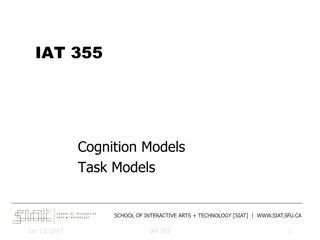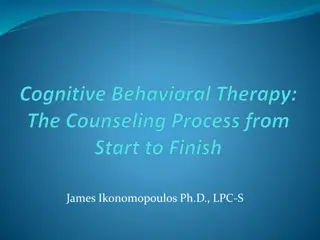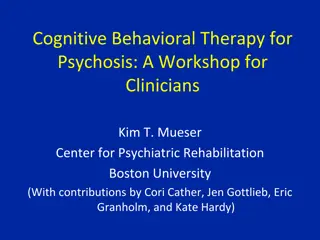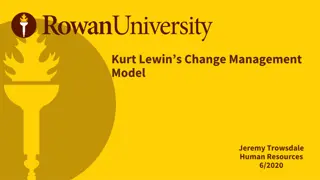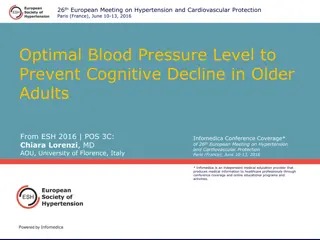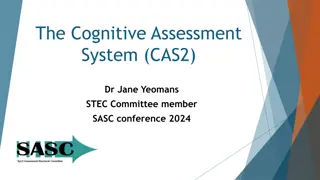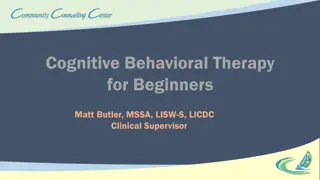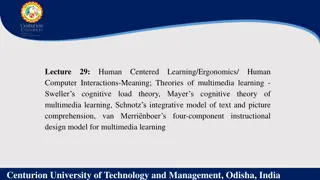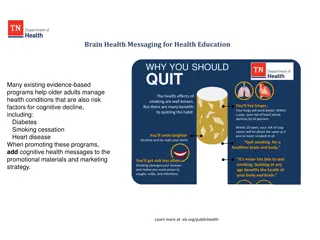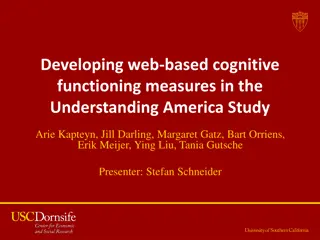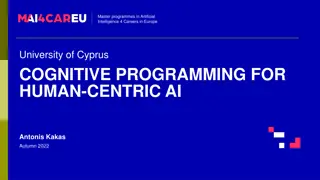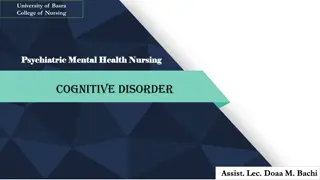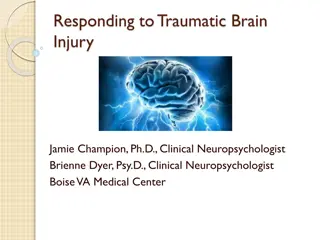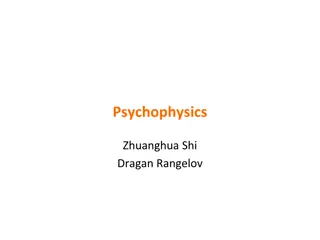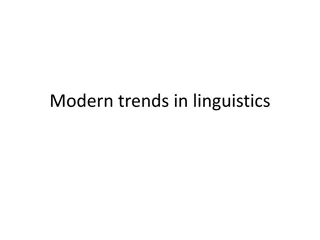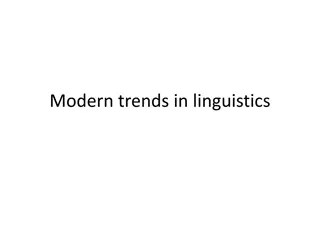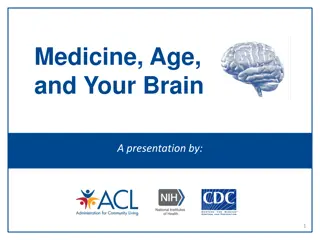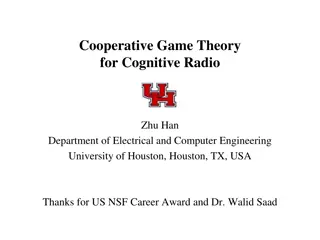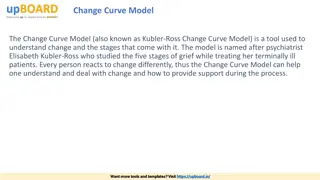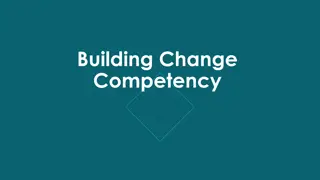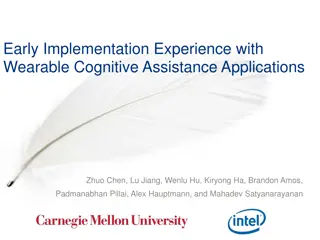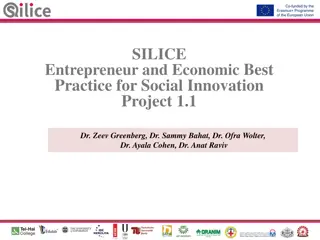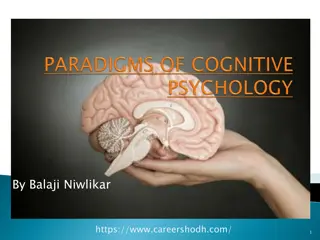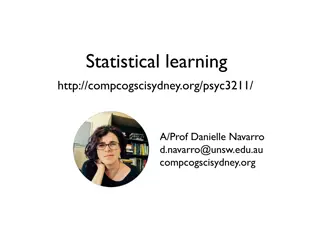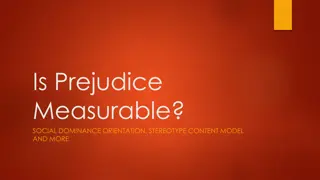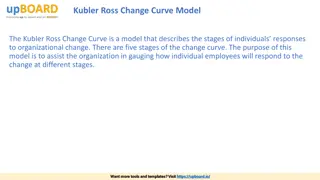Cognitive Model of Stereotype Change: Three Models Explored
The Cognitive Model of Stereotype Change, as researched by Hewstone & Johnston, delves into three key models for altering stereotypical beliefs: the bookkeeping model, the conversion model, and the subtyping model. These models suggest strategies such as adding or removing features to shift stereotypes, ultimately aiming to adjust the accepted traits and behaviors associated with particular groups. Understanding these models can offer insights into gradually modifying and updating stereotypes through the influence of disconfirming information.
Download Presentation

Please find below an Image/Link to download the presentation.
The content on the website is provided AS IS for your information and personal use only. It may not be sold, licensed, or shared on other websites without obtaining consent from the author. Download presentation by click this link. If you encounter any issues during the download, it is possible that the publisher has removed the file from their server.
E N D
Presentation Transcript
Cognitive model of stereotype change: Hewstone & Johnston
Three models of stereotype change The authors defined stereotype change as A) it must be possible to change stereotypes by removing features Decreasing stereotypical attributions
Three models of stereotype change The authors defined stereotype change as B) it must be possible to change stereotypes by adding features Increasing counter-stereotypical attributions
Three models of stereotype change Both changes alter the the acceptable range of traits/behaviors associated with the group And both changes modify the interrelation between features Of course, these changes are not mutually exclusive
Three models of stereotype change The three models that in principle can alter people s stereotypical beliefs are The bookkeeping model The conversion model The subtyping model
Three models of stereotype change The bookkeeping model proposes a gradual modification of stereotypes by the additive influence of each piece of disconfirming information
Three models of stereotype change Any single piece of disconfirming information elicits a minor change in the stereotypes Major change occurs gradually
Three models of stereotype change The bookkeeping model is then a feature-frequency model The frequency of occurrence of individual feature is computed and stored in memory, composing the representation of the category
Three models of stereotype change It s not clear what is the unit of disconfirmation: is the number of members that run against the stereotype or is the number of disconfirming information
Three models of stereotype change The conversion model predicts a radical change in response to dramatic disconfirming information but no change in response to minor disconfirming information
Three models of stereotype change Extreme disconfirming information, compared to less extreme disconfirming information, should provoke greater stereotype change.
Three models of stereotype change This prediction is based on the idea that extreme disconfirming members are extremely salient and their content should be more available when judging the group as a whole
Three models of stereotype change The subtyping model proposes a hierarchical structure, discriminations within the group being created in response to disconfirming information This leads to the formation of a subtypes which are considered as unrepresentative of the category as a whole
Three models of stereotype change The disconfirming members could be then perceived as atypical with respect to the group The atypical member is then seen as an exception, irrelevant to the group The member-to-group generalization (inductive inference) is blocked, as inductive processes are less likely to occur if the member is atypical
Three models of stereotype change Alternatively, the disconfirming members failed to activated the category (as it has been re-categorized) The disconfirming member is not processed as member of the target group, but it can be re-categorized (remember the example of the Black scientist) When thinking about the group, that member is not activated/available the group stereotype remained intact
Three models of stereotype change The subtyping model is a model of no-change Although it indicates that changes might occur when perceivers is confronted with a moderately disconfirming member. That is, a member that is still perceived, at least in part, to be associated with the group This prediction is antagonist to the prediction derived from the conversion model
Three models of stereotype change Study 1: Test what model is more effective in changing stereotypes (bookkeeping vs. conversion vs. subtyping) That the role of several potential mediating variables in this respect (process)
Three models of stereotype change Study 1 aims to clarify which is the disconfirming unit.. the number of disconfirming information is held constant while varying the number of disconfirming member This would allow to test whether the disconfirming unit is the number of disconfirming member (it does not allow to test whether the number of disconfirming information is the disconfirming unit)
Three models of stereotype change MATERIAL: PILOT 1 N = 10 students were asked a) about groups around the university b) which, if any, groups were distinctive and what it was made tme stand out what characteristics the group posses six groups were the most frequently reported the characteristics of these six groups fed the next pilot
Three models of stereotype change MATERIAL: Pilot 2 N = 12 students were asked to rate each of these six groups on a) the characteristics reported in the previous pilot, b) additionally traits. 7-point scale, ranging from 1 = not at all to 7 = a lot
Three models of stereotype change MATERIAL: Pilot 2 taking into account the structure of the scale: 7- point scale, ranging from 1 = not at all to 7 = a lot traits were classified as: Strongly characteristic: the mean score was among the 10 highest scores and there were no more than two subjects who rated the trait in the opposite direction of the scale midpoint from the group mean)
Three models of stereotype change MATERIAL: Strongly uncharacteristic: the mean score was among the 10 lowest scores and there were no more than two subjects who rated the trait in the opposite direction of the scale midpoint from the group mean)
Three models of stereotype change MATERIAL: irrelevant: the mean score for that trait was within 1 point of the scale midpoint and there were no more than two subjects who rated the trait more than 2 points from the scale midpoint)
Three models of stereotype change Pilot 3 For each characteristic (see Pilot 2), a behavior that confirm this trait and a behavior that disconfirms this trait was found N = 8 participants rated how good example of the trait was the behavior Likert scale ranging from 1 = very bad to 6 = very good
Three models of stereotype change Pilot 3 Likert scale ranging from 1 = very bad to 6 = very good Behaviors that did not differ from 1 and Behaviors that did not differ from 6 were retained.
Three models of stereotype change Study 1: Participants were presented with eight members Each member was described by six behaviors Regardless of the between subject variable, namely how the inconsistent pieces of information were concentrated of disperse, the number of disconfirming information was kept constant
Three models of stereotype change Study 1: Three formats: Concentrated Intermediate Dispersed
Three models of stereotype change Study 1: Regardless of the format, of infos were I, of infos were C and were irrelevant
Three models of stereotype change m1 I I I I I I m2 I I I I I I m3 C C R R R R m4 C C R R R R m5 C C R R R R m6 C C R R R R m7 C C R R R R m8 C C R R R R concentrated
Three models of stereotype change m1 I I I C R R m2 I I I C R R m3 I I I C R R m4 I I I C R R m5 C C R R R R m6 C C R R R R m7 C C R R R R m8 C C R R R R Intermediate
Three models of stereotype change m1 I I C C R R m2 I I C C R R m3 I I C C R R m4 I I C C R R m5 I I C C R R m6 I I C C R R m7 C C R R R R m8 C C R R R R Dispersed
Three models of stereotype change Study 1: dependent variables Participants estimated the percentage of behavioral instances they had read that confirmed, disconfirmed, or were irrerlevant to the stereotype (discounting measure) Participants rated how characteristic each of the six traits represented in the stimulus information were of the group in general (group stereotype measure)
Three models of stereotype change Study 1: dependent variables Participants estimated how many of the group members were typical or atypical of the group (discounting measure) Participants rated the typicality of each group members with respect to the group as a whole (typicality measure)
Three models of stereotype change Study 1: dependent variables Participants took part in a sorting task. They were presented with the description of each members and asked to sort the members into piles on the basis of perceived similarities between members of the same pile and perceived differences between members of different piles (subtyping measure)
Three models of stereotype change %of perceived information concentrated intermediate dispersed Consistent* 52.37a 38.75b 47.53a Inconsistent* 34.55a 41.40ab 44.33b irrelevant 17.29a 14.23a 18.98a
Three models of stereotype change Trait ratings (group stereotype) concentrated intermediate dispersed Consistent 5.54a 5.80a 5.83a Inconsistent* 2.75b 3.41a 3.63
Three models of stereotype change Estimated number of concentrated intermediate dispersed Typical 4.50a 3.78ab 3.40a Atypical 2.71a 3.33a 3.08a
Three models of stereotype change typicality concentrated intermediate dispersed Confirmers 5.14a 5.25ab 5.38 Disconfirmers* 2.45a 3.71a 3.92a
Three models of stereotype change Subtyping concentrated intermediate dispersed #Piles 3.03a 3.25a 3.38a
Three models of stereotype change Study 1: Mediation Analyses confirmed that the dispersed condition led participants to change their stereotype more so than participants in the concentrated condition, because Participants in the dispersed condition perceived the disconfirmers as more typical than participants in the concentrated condition
Three models of stereotype change Study 1: Hence, participants in the dispersed condition perceived the disconfirmers to be still representative of the group as a whole Participants then used them as a basis to judge the group in question, provoking the revision of stereotypes
Three models of stereotype change Study 1: However, the lack of control condition (no exposure to members and judgment of the group as a whole), lets us read the results in another manner
Three models of stereotype change Study 1: Mediation Analyses confirmed that Compared to participants in the dispersed condition, the concentrated condition led participants to maintain their stereotype, because Participants in the concentrated condition perceived the disconfirmers as more atypical than participants in the dispersed condition
Three models of stereotype change Study 1: Hence, participants in the concentrated condition perceived the disconfirmers to be unrepresentative of the group as a whole, and dismissed as irrelevant case Participants did not use them as a basis to judge the group in question, leaving the stereotype intact
Three model stereotype change Study 2 Premise: Reading time might constitutes a proxy of information processing Different time to read confirming and disconfirming information
Three model stereotype change Study 2 Confirming information, given its high category fit, makes the category content accessible Confirming information is redundant with category content, as it confirms what it s expected Fast reading time
Three model stereotype change Study 2 Disconfirming information, if the category is salient, violates the category contents The reader frequently tries to integrate the incoming information to the category contents Reading times slowed down
Three model stereotype change Study 2 Procedure: Exactly the same as in Study 1. No intermediate condition. Only dispersed and concentrated.
Three models of stereotype change m 1 m 2 m 3 m 4 m 5 m 6 m 7 m 8 m 1 I m 2 I m 3 I m 4 I m 5 I m 6 I m 7 C m 8 C Dispers. concen. I I C C C C C C I C C I C C C C C C I I I C C I C R C R C C R R I I I I I I I I I I C C C C C R R R R R R R R R R R R C R R R R R R R R R R R R R R R R R R R R R R R R R R R R
Three model stereotype change It might be plausible that disconfirming members, given their low category fit, did not make the category content accessible in the concentrated condition, whereas disconfirming members, given their sufficient category fit, made the category content accessible in the dispersed condition
